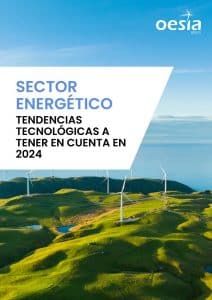
Introduction
The energy sector and Utilities in general are in a process of total transformation, where technologies that are foreign and transversal to the sector’s own business, such as ICTs, are for the first time conditioning the medium and long-term strategies of the leading companies in energy management.
And as we will be able to see over the coming months, we are at a key moment of digital transformation, with the sector facing new challenges and increasingly ambitious objectives. What are the challenges, actions and technologies that are being put on the table to overcome them? In addition to the Generative AIThe main protagonist of 2023, which will evolve to be the focus of future structural improvements in companies, other areas to watch in 2024 will be: the new approaches to carbon footprint reductionthe highest security through the post-quantum cryptographythe intrinsic knowledge management companies in the absence of specialized resources, and the advanced systems of demand forecasting and management.
Carbon footprint reduction
One of the top priorities for all organizations is to continue to control the reduction of the carbon footprint they generate in their daily operations.
In 2024, this process will be maintained and even intensified.
, in both public and private organizations. This responsible mission aims to leave the next generations a world at least in the same condition as the one we received, although this requires a certain catharsis in the operating models of each company.
Companies in the energy sector are already
are already betting on green and renewable energies, investing
investing to switch to a self-supply
to a self-supply model
less dependent on the foreign market and, above all, more secure,
more secure
. And to achieve this optimization in energy efficiency, Artificial intelligence (AI) and machine learning (ML) are set to become essential tools in 2024.. It is essential to emphasize that all these elements cannot be treated as independent subsystems: an intelligent transversal monitoring and management of all of them must be implemented. This will make it possible to develop a more robust, flexible and efficient energy system, capable of meeting the challenges of the new energy model.
The energy transition is changing the participation of renewable energies in new distributed generation systems.
new distributed generation systems
This is one of the best solutions to generate energy only when it is needed. This shared system is expected to increase decarbonization by using more complex and optimized predictive models for automated analysis and decision making. The The rise of 5G networks and IoT solutions will also help to control and sustainably manage operations.The company’s solutions are designed to optimize the use of resources and provide real-time status information, whether at generation centers, in the distribution environment or in the storage environment.
Knowledge management
One of the essential ways for the transformation and digitization of companies in the energy sector is the adoption of technologies and solutions that allow them to to manage in an efficient and agile way the great mass of knowledge distributed among workersas well as the high volume of information
information generated in the daily operations of each business
of each business, all in real time
in real time
.
The
IA
Again, it will be of great help in this endeavor. Their use and tools allow to streamline and improve the process of capture, organization and utilization of organizational knowledge. The new service must
integrate all types of multi-format information
text, documents, video, image, audio, DB, etc., and must be complemented with business functions and applications for maximum optimization of responses.
Thanks to it, corporate technology will undergo a major transformation in the coming years. And the combined power of cloud and AI will lead to a spectacular reinvention of information management, making their daily work routine more efficient, to the benefit of managers, who will be helped in day-to-day management and strategic decision making. This will provide organizations with greater integration, scalability, performance, cost savings and security.
In addition to relying on third-party tools, there will be a trend for companies in the energy sector, to create more
proprietary knowledge management services
(developed through ad-hoc AI),
to adapt them to their particular needs as the organization grows or changes.
and obtain more efficient, competitive and customized results, differentiating itself from its competitors’ offerings and operations. The closer tools are developed to the requirements and less generalist offers of a business, the greater the return in cost optimization and internal operational dynamism.
Demand forecasting system for the energy sector
Energy demand forecasting plays a key role in the management and planning of the resources required for energy generation, distribution and utilization. Predicting energy demand is a complex task influenced by factors such as weather patterns, economic conditions and societal behavior..
The evolution of markets towards a freer economy in which the roles of producer and consumer overlap and even become confused has reached the electricity sector on a massive scale in 2023. The
diversification of production or the ability to alter consumption patterns mean that participation in electricity markets and system operation must take a step forward to efficiently manage this dynamic behavior.
make it necessary for participation in electricity markets and the operation of systems to take a step forward in order to efficiently manage this behavioral dynamization.
Technology has increased the number of possible decisions that can be made by both producers and consumers.. The number of technologies capable of producing energy is increasing, but the number of restrictions on their hours of operation is increasing. The number of technologies that consume electricity is increasing, but so is the capacity to program consumption and even to store energy. In this ever-changing environment,
participating stakeholders data management systems to support their decision-making process to ensure
to support their decision-making process to ensure that decisions lead to a more efficient industry from which we will all benefit.
Demand forecasting is a crucial piece of information
crucial information for managing the execution of bids and offers, both for purchase and sale in the electricity market.
both for buying and selling in the electricity market, and also for operating the electricity market efficiently and reducing the cost overruns of technical adjustments.
reduce the cost overruns of technical adjustments
. There are multiple forecasting horizons for electricity demand, but
the most critical is the short term forecasting
which includes forecasts for the next few hours to the next few days.
The problem of short-term forecasting in the energy sector is complex because the number and type of variables that influence demand varies from one case to another and the relationships established between these variables and demand are often of a markedly non-linear nature. Therefore, companies will implement from 2024 onwards, in support of operational processes, advanced developments and innovative applications based on predictive analytics on the information collected, as well as the massive use of AI, using neural networks and hyper-automatics, in the form of self-organizing maps.. New designs and forecasting engines capable of capturing the complex relationships between demand and input information, with an emphasis on the essential quality of the data collected, are therefore expected by 2024.
Quantum encryption to protect infrastructures
Guaranteeing energy supply not only means being able to respond to demand by adjusting supply accordingly. It also requires having robust infrastructures that are not vulnerable to potential external threats that could compromise energy supply. We must be able to anticipate any scenario, as the energy sector is considered one of the most strategic for all governments in the world and extremely critical in the face of new cyber-attack models.
Today we are already immersed in a veritable cyber arms race, in which advances in computing power must be accompanied by reinforced digital defense mechanisms.
advances in computing power must be accompanied by reinforced digital defense mechanisms.
. For example, AI and machine learning (ML) are increasingly used in threat detection and response, while the zero trust security model may become a global norm.
In this environment, a new threat to the energy sector and its associated companies is rapidly emerging, driven by the development of quantum computing, which renders current security and encryption standards obsolete.
Therefore, throughout 2024, we will see a focus on the development of quantum-resilient algorithms.
development of quantum-resistant algorithms, becoming an urgent need to maintain data privacy and security in the future.
This will become an urgent necessity to maintain data privacy and security in the future.
“Post-quantum cryptography” (PQC), i.e., the creation of new encryption algorithms that are believed to be resistant to quantum attacks, will require organizations and vendors supplying energy companies to be
prepared to migrate to PQC in the coming years.
. This emerging shift promises to alter the very basis of enterprise cybersecurity standards. And all business leaders and technology experts will be affected by this approaching milestone as more and more organizations begin their quantum transition.
A 2024 full of opportunities
We see that there are many challenges that companies in the energy and utilities sector will have to face or consider during 2024. To the aforementioned, we could add the massive use of 5G and IoT or the settlement of tools such as virtual simulators and digital twins. The future is already here. And important windows of opportunity are opening up for service providers such as Grupo Oesía, expert in data management, AI, predictive analytics and E2E security in all its variants.among other innovative technologies. Grupo Oesía committed to being an enabler of growth, efficiency and sustainability for all companies in the energy sector. Our goal is to be a dynamic partner in the evolution of companies to Data Driven, and our expertise in security and automation of complex processes and, above all, our experience in the management of massive amounts of data allows us to helping to optimize costs in operational processes while collaborating with our partners to reduce our carbon footprint. We are prepared to solve the challenges of 2024 and problems that have not yet manifested themselves.
Alberto López Chamorro, Head of Energy and Utilities in Grupo Oesía
